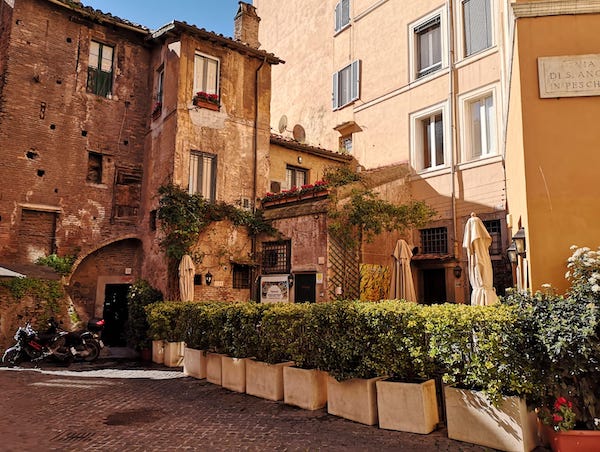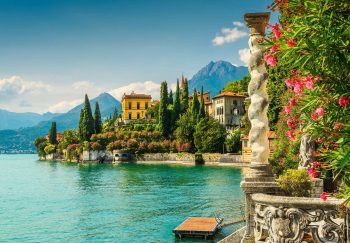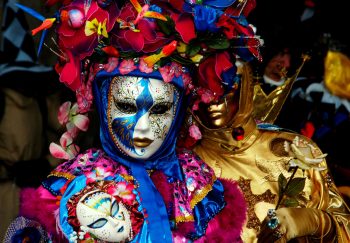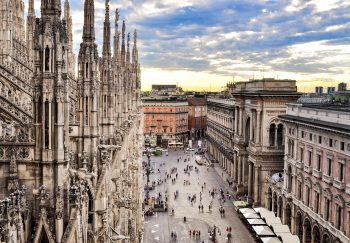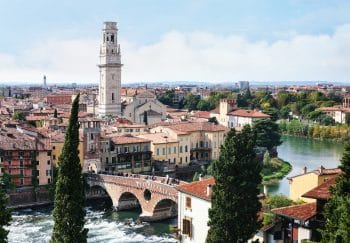Notable: Our Rome as a Local Tour takes you to some of Rome’s most amazing under-the-radar attractions. We are confident that you will not be disappointed by the information you have read.
The best attraction in Rome is hidden in the city’s heart. It is also one of Rome’s least-known. This beautiful and vibrant neighborhood, which is the oldest Jewish community in Europe, is just as important to the history of the city. We invite you to follow us to the Jewish Ghetto in Rome to learn how Jews have shaped Rome’s Eternal City.
In the Rione Sant’Angelo in the southern Campo de’Fiori, the Ghetto was founded in 1555. Its boundaries were established by a Papal Bull, along with discriminatory laws regarding the professions Jews could or could not hold. One of the most accepted occupations, selling fish, is still being called by streets around the old fish market. Although the area now has some of Rome’s highest property prices, the original Jewish Ghetto, also known as the Roman Ghetto, was crowded and walled in. It was built on low-lying, malarial land that was subject to frequent floods from Tiber. It was a grim existence until 1888, when the Ghetto walls collapsed.
The Roman Ghetto was a place where Jewish culture thrived. However, the area also saw one of the most devastating episodes of Nazi occupation during World War II. Many people in Rome, including The Vatican, gave their gold after the German government declared that Rome’s Jews would not be deported to concentration camps if they paid a ransom for gold. However, it is still debated whether the Vatican accepted the offer. The required amount was not raised by the Jewish community. Nazi soldiers invaded the area on October 16, 1943, and deported between 1,000 to 2,000 people. Only 16 people survived.
The area has developed into a charming neighborhood with many restaurants, churches and synagogues. These synagogues combine the richness of Roman architecture with jewish culture. The ruins of an ancient Portico, known as the Portico d’Ottavia (under 20 feet below street level), are a reminder of history and the changes that have occurred over time.
Teatro Marcello
The Teatro is named after Marcus Marcellus, the nephew of Emperor Augustus, and was completed in 13 BC by Augustus. Because of its similarity to the original Colosseum, it’s also called the Jewish Coliseum. The ancient open-air theater was once home to approximately 11,000 to 22,000 spectators. It could also be used for singing, dancing, or acting. It is located in the Rione di Sant’Angelo and hosts different shows throughout the year. You can see the apartments on the top floors, which offer stunning views of the city centre and are occupied daily by some of the oldest Jewish families in the area.
The Great Synagogue
The Tempio Maggiore di Roma, also known as the Great Synagogue, is the largest synagogue anywhere in Rome or possibly in Italy. This striking building is quite new, even by Roman standards. The original ghetto synagogue, built in 1870 by people of Jewish faith, was demolished and plans began for the Great Synagogue. In 1901, the cornerstone was laid and the Synagogue was completed in 1904. It is a true baby in the Roman skyline. Contact via Catalana or Roma. 06-6840061. Mid-June through mid-September: Sunday through Thursday, 10am to 7pm and Friday, 10am to 4pm. Other times: Sunday through Thursday, 10am to 7pm, Friday, 9am to 2pm.
Jewish Museum of Rome
. It is located under the Great Synagogue and displays silverware, textiles, parchments, and marble carvings from collections of the Jewish Community of Rome. It gives an overview of the history of Rome’s Jews and the Jewish Ghetto. Start your explorations of the area here to gain some context. The museum visit includes entry to the Great Synagogue. The admission fee is 10 euros. How to Visit Via Catalana, Roma or Tel. +39 06-6840-0661
La Bocca della Verita
The Mouth of Truth or Bocca Della Verita is a marble-carved image of a man’s face. The sculpture, which is located at the Santa Maria in Cosmedin Church’s entrance since the 17th Century, is believed to date back to the first century. Although we don’t know if it is connected to Rome’s Jewish Ghetto or Judaism, there are many legends about its origins. They include that it was part of an ancient fountain, a church, and a manhole cover. But the most bizarre part is its ability to detect lies. Romans believed that if your hand was in the mouth of a sculpture, it would bite your hand! This belief dates back to the Middle Ages. How to visit The Church is open from 9:30 a.m. – 5:30 p.m. Piazza della Bocca della Verita, 18, Roma, tel. +39 06 678 7759.
The Fontane delle Tartarughe
The Turtle Fountain is a late Renaissance fountain located in the rione Sant’Angelo. It was once called the Dolphin Fountain. However, it used to have dolphins at the place where the turtles are now located. Low water pressure forced them out and they were replaced by the turtles that make the fountain complete. The original purpose of the fountain was to be a drinking fountain. However, water came from the Acqua Vergine in Rome, which is a major landmark for the sixth-century Romans.
…. Maybe even a Church
Surprisingly, more than 15 churches can be found in the area of the former Jewish Ghetto. Some of the most famous are Chiesa di Santa Maria del Pianto, Chiesa di San Tommaso ai Cenci, Chiesa di Santa Caterina dei Funari, and Chiesa di San Stanislao dei Polacchi. Our Insiders Guide to Rome’s Jewish Ghetto was helpful. You can also check out our other Insiders Guides: A Guide to The Amalfi Coast, The Tuscany Guide and Outdoor Adventures Guide
